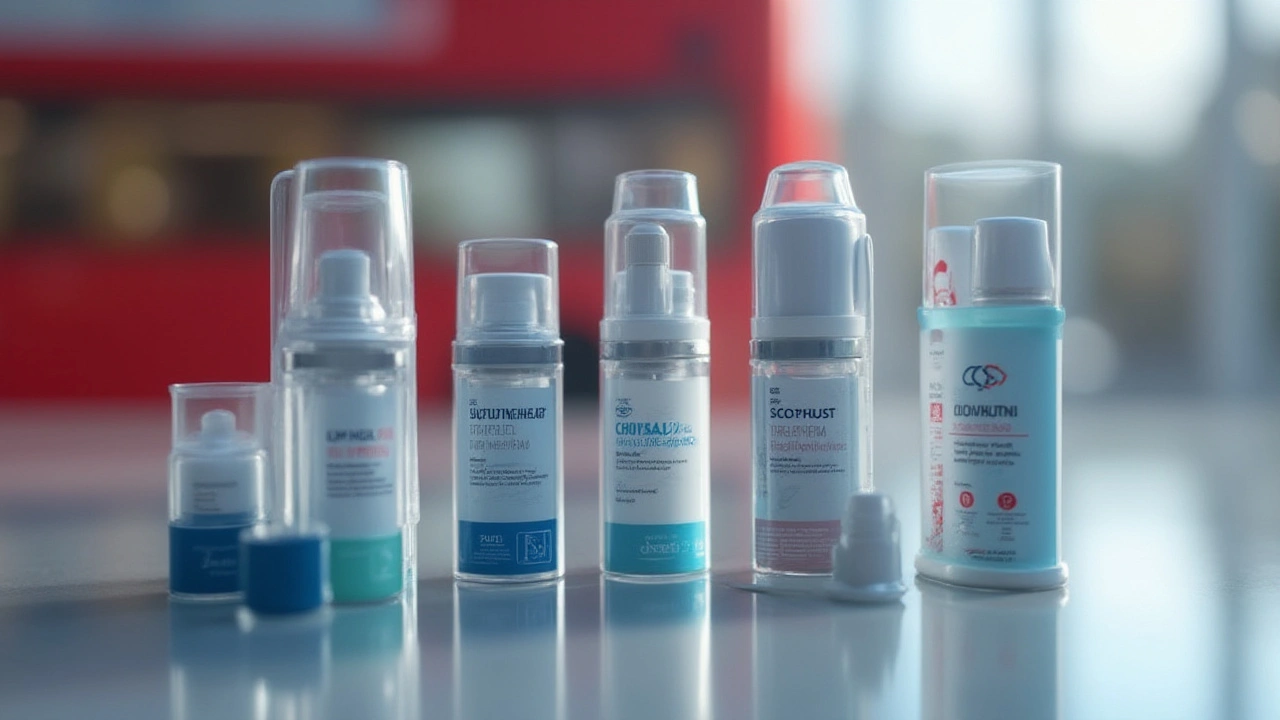Standing in the pharmacy, weighing your inhaler options, can feel like high-stakes speed dating. Some inhalers promise fast relief, others offer long-term protection, and a few try to do it all. What most people don’t realize is just how quickly the landscape is changing—especially for those living with moderate to severe COPD in 2025. If you’re still using the same inhaler you started with five years ago, you might be missing out on new therapies that could change how you breathe day-to-day.
Understanding Triple-Therapy Inhalers: More Than Just Symbicort
Symbicort, a household name for many with COPD, isn’t even the most sophisticated option anymore. While this dual-therapy inhaler (budesonide/formoterol) does a solid job reducing inflammation and relaxing airways, newer triple-therapy inhalers have pushed the standard higher. These advanced inhalers combine three medications: an inhaled corticosteroid (ICS), a long-acting muscarinic antagonist (LAMA), and a long-acting beta agonist (LABA).
The idea is simple: hit COPD from every angle. Let’s break down how they work:
- ICS: Brings down inflammation inside your lungs, tackling flare-ups before they start.
- LAMA: Relaxes airway muscles for easier breathing, and helps block the signals that tighten up airways in the first place.
- LABA: Keeps your airways open for up to 24 hours, preventing bouts of breathlessness.
Here are the top triple-therapy inhalers that have been shaking up the market in Australia this year:
- Trelegy Ellipta (fluticasone furoate/umeclidinium/vilanterol): This once-daily inhaler is designed for people who need all three types of medicine, often after single or dual therapies aren’t enough. Clinical studies from 2023 show that Trelegy cuts COPD exacerbations by 25-35% compared to dual therapy.
- Trimbow (beclometasone/formoterol/glycopyrronium): Used twice daily, Trimbow is quick to act and often recommended for those with frequent symptoms. Many Aussies report fewer "bad days" and less reliance on rescue inhalers after switching.
- Breztri Aerosphere (budesonide/glycopyrronium/formoterol): It’s one of the newer arrivals, and studies from the last couple years suggest it helps some people lower their risk of sudden hospital trips. Invented to bridge a gap for people who need an easier-to-inhale device, it’s gaining popularity in clinics across Melbourne.
A lot of people wonder: Are triple-therapy inhalers really worth it, or is it just more medicine for the sake of it? While everyone’s situation is different, the stats don’t lie. Take a look at this head-to-head comparison from a 2024 Melbourne study:
| Inhaler | Exacerbation Reduction (%) | Avg. Rescue Inhaler Use (day/week) |
|---|---|---|
| Symbicort (dual) | 18 | 5.8 |
| Trelegy Ellipta (triple) | 35 | 2.9 |
| Trimbow (triple) | 29 | 3.2 |
| Breztri Aerosphere (triple) | 32 | 3.1 |
You can see Symbicort works pretty well, but these triple-therapy inhalers take things up a notch—especially if you’re tired of feeling like your rescue inhaler is your best mate.
If you want to dig deeper into alternatives and similar medications, this drugs like Symbicort roundup lays out how each option stacks up for both asthma and COPD.
Biologics: The Cutting Edge For Severe COPD
Biologics used to sound like something only advanced cancer patients worried about—but in 2025, they’re on the radar for severe COPD too. These aren’t the regular pills or puffs. We’re talking high-tech treatments grown from living cells, aimed at switching off the body’s out-of-control inflammation that makes breathing a nightmare.
Right now, biologics are mostly prescribed for people who just aren’t getting relief from inhalers alone. This includes those with regular flare-ups (exacerbations), hospital visits, or oxygen at home. According to a 2024 Australian Thoracic Society report, biologics are uncovering new hope for about 10-15% of people with severe COPD.
The most promising biologics include:
- Dupilumab: Originally used for asthma and eczema, Dupixent (dupilumab) is now showing results for a specific subset of COPD patients: those with high eosinophils (a type of white blood cell that drives inflammation). In a 2024 trial, folks on Dupilumab had nearly 30% fewer exacerbations compared to the placebo group. Downside? It’s expensive—think $1000+ per injection monthly if you’re not on a supported plan.
- Benralizumab: This injectable is another asthma success story making inroads into COPD care. Benralizumab works by starving those eosinophils, and some Melbourne clinics are using it for patients with frequent attacks despite triple therapy. The early word? Less coughing, fewer colds turning into hospital stays, but it’s only for those meeting certain blood test thresholds.
Here’s what the current stats say:
| Biologic | Reduces Exacerbations (%) | Works For |
|---|---|---|
| Dupilumab | 30 | High eosinophils |
| Benralizumab | 25-27 | High eosinophils |
“We’re just starting to see the massive potential of biologics in COPD, but careful selection is key—one size does not fit all,” says Dr. Lisa Bennett, consultant respiratory specialist at Royal Melbourne Hospital.
If you’re curious whether you’d qualify for a biologic, you’ll need to work with your doctor to measure inflammatory markers and track exacerbation frequency. Some people are even enrolling in trials for newer agents set to launch in late 2025. Don’t let the injectable route scare you—many people say the relief from flare-ups is well worth the switch.

Side Effects, Costs, and Everyday Tips
Medications come with their baggage, and the new class of COPD treatments is no exception. Triple-therapy inhalers, despite their benefits, can still carry the risk of oral thrush, a bit of hoarseness, and sometimes higher blood pressure if you already have cardiovascular troubles. Want to keep side effects down? Rinse your mouth after every puff—old advice, but still the best trick in the book.
With biologics, people usually tolerate them well, but you might see injection site redness, headache, and rarely, a mild increase in infections. Since biologics suppress part of your immune response, your doctor will keep an eye out for odd infections or allergic reactions. The price is the real kicker. Even with Australia’s PBS subsidy, most biologics remain expensive unless you’re in a qualifying group or on a clinical trial.
If you’re on a budget, keep your GP in the loop. Sometimes, older dual-therapy inhalers like generic Symbicort remain a fine option if your case isn’t severe. But if you’ve racked up ER visits or hospital days in the last year, it’s time to look at the next rung up. Ask about patient support programs—pharmaceutical companies sometimes offer discounts or compassionate access if you’ve hit a wall with standard treatment.
A few day-to-day tips from folks who’ve made the switch:
- Use a spacer if you have trouble with coordination—especially for metered-dose inhalers.
- Set alarms for your inhaler doses until it becomes a habit (makes a world of difference for results).
- Track symptoms in a simple diary—so your doctor gets an honest picture, not just a snapshot at appointments.
- Experiment with breathing techniques—pursed-lip breathing during stairs or quick walks gives your meds a boost.
It’s no secret that finding the right medication is part science, part trial and error. Don’t lose patience if the first option doesn’t feel perfect—people often need two or three adjustments. The best news? New options are showing up on PBS lists all the time, so staying informed is your secret edge.
Future Trends: What’s Next After Triple-Therapy and Biologics?
The horizon of COPD treatment is busier than a Flinders Street train station at rush hour. Beyond better versions of today’s inhalers, researchers are working on daily pills that target the root causes of inflammation, new antivirals for viral COPD flares, and even gene therapies that could one day tune down your response to pollution or allergens. Some big names include ensifentrine, a dual PDE3/4 inhibitor inhaler, and tezepelumab, a biologic already used for asthma now being studied in COPD.
One thing is clear: If it feels like you’re stuck with old routines, don’t just assume nothing has changed. For 2025, regular reviews with your respiratory team are more important than ever. Switching from dual to triple therapy, or even qualifying for a biologic, could mean spending your time outdoors with mates rather than stuck at home coughing.
The takeaway? It isn’t just about what’s written on your prescription—but how much easier you breathe, how rarely you see the inside of a hospital, and what sort of life you can live. Don’t settle for last decade’s treatments when the future is arriving now, often script-by-script.





Jacqueline von Zwehl
Thanks for the comprehensive guide! It’s really helpful to see the data broken down by inhaler type and the real‑world impact on exacerbations. I especially appreciate the practical tips about rinsing your mouth and using spacers. Keeping the tone friendly makes the info more approachable for everyone.
Christopher Ellis
One could argue that the hype around triple‑therapy inhalers distracts from the bigger picture of lifestyle changes. The focus on devices often overlooks the role of smoking cessation and exercise. Still the data does show meaningful reductions in flare‑ups, which is worth noting.
kathy v
America has always been a land of innovation and we should be proud when our pharmaceutical companies lead the world in developing advanced COPD therapies. The new triple‑therapy inhalers are a testament to that spirit of progress and they deserve to be embraced by patients across the nation. It is not enough to cling to older drugs when superior options are available, especially when the statistics show a dramatic drop in hospital visits. The data from Melbourne and Sydney is clear: exacerbations are cut by nearly a third when patients switch to triple therapy. This is not just a marginal gain but a life‑changing improvement for many. Our healthcare system can save millions by reducing emergency department overload. Moreover, the convenience of once‑daily dosing in devices like Trelegy can enhance adherence, something that has eluded many patients for years. We must recognize that simply prescribing the same inhaler for a decade is an outdated practice. The pharmaceutical lobby may try to downplay the benefits to protect legacy products, but the evidence speaks for itself. Patients deserve to have the best tools at their disposal, and that includes embracing newer inhalers that target inflammation, bronchoconstriction, and airway remodeling all at once. The cost argument is often used as a barrier, yet the long‑term savings from fewer hospitalisations outweigh the upfront price. Our doctors should push for insurance coverage and patient assistance programs that make these inhalers accessible. The government’s role is vital in ensuring equitable access regardless of socioeconomic status. In addition, the rise of biologics offers hope for the most severe cases that have exhausted inhaler options. These advanced treatments, though pricey, can prevent a cascade of complications that would otherwise be inevitable. Finally, let us remember that progress in COPD care is a collective effort that reflects the ingenuity and compassion of the entire medical community, and we must celebrate these breakthroughs.
Jorge Hernandez
Hey, great post! I’ve been on Breztri for a few months and it’s made a real difference 😊. Rinsing after each puff really helped with the throat irritation I used to get. If you’re worried about dosing, the twice‑daily schedule can actually keep you on track easier than you think. Keep sharing these updates, they’re super useful!
Raina Purnama
Thank you for compiling this information so clearly. It is valuable to see the comparative tables and understand the side‑effect profiles. I especially liked the reminder about using a spacer for better inhaler technique. This will help many patients make informed decisions.
April Yslava
Do you realize how big pharma is pushing these inhalers just to keep us dependent on their endless supply chains? They claim it’s about patient benefit but the real motive is profit, and the government is turning a blind eye. The biologics you mentioned are ridiculously priced, which only fuels the cycle of control. Some even say the data is being tweaked to look better than it actually is. Stay vigilant, because the next “revolution” might be another way to lock us into higher costs.
Daryl Foran
Look, the numbers dont lie but the studies are often biased. Those triple inhalers are good but they arent a magic bullet. Patients still need to watch for thrush and other side effects. Don't just jump on the hype without askin your doc.
Rebecca Bissett
Wow!!! This article really hits home!!! I felt so seen reading about the struggles with side effects!!! It’s amazing how the right inhaler can change everything!!!
Michael Dion
Looks solid.
Trina Smith
From a philosophical standpoint, even a brief affirmation can echo deeper truths about medical progress 😊. It reminds us that concise feedback still carries weight. In the grand tapestry of patient care, every voice matters, no matter how short.
josh Furley
While the guide is thorough, the jargon-heavy sections might alienate newcomers. Simple language can be more effective, especially when discussing dosage regimens. Yet, the biochemical mechanisms are fascinating and deserve the technical terms. People love the buzzwords, but clarity should win. 🚀
Jacob Smith
Yo! This guide is lit, man! Keep pushin for those better inhalers, you got this 💪. Don't forget to talk to your doc about PBS support. And remember, consistency is key-set those alarms! Let's crush those flare‑ups together.
Chris Atchot
First, let me say that the article is exceptionally well‑structured, and the data tables are, without doubt, very informative; however, there are a few minor points that could be refined. For instance, the term “high‑eosinophils” might be more accurately phrased as “elevated eosinophil counts.” Additionally, the usage of “sometimes” in the side‑effect section could be replaced with a more precise statistic, if available. Overall, the piece offers a comprehensive overview, and I commend the author for such a thorough compilation.
Shanmugapriya Viswanathan
Honestly, anyone who doubts the superiority of our domestic inhaler research is just naive :) Our labs are leading the world, and the data proves it. Don't listen to foreign critics, they don't understand our patients.
Rhonda Ackley
Oh my goodness, where do I even begin? Reading this guide felt like watching a drama unfold on the big screen, with each inhaler taking its turn as the misunderstood hero. The way the author described the transition from dual to triple therapy was practically a saga of redemption. I could almost hear the background music swell as the statistics on exacerbation reductions were revealed, like a plot twist you never saw coming. And then, just when you think the story is over, the biologics make a dramatic entrance, cloaked in mystery and expensive price tags. It’s as if the narrative is whispering, “Will you, dear patient, choose the safe path or embrace the unknown?” The gentle reminders about rinsing your mouth after each puff are like the quiet, reassuring side characters, always there to keep the drama from turning tragic. Meanwhile, the tables-oh, the tables!-serve as stage directions, guiding us through the action with crisp precision. As I read on, I felt tension building, like waiting for the final curtain call, and when the article concluded, I was left both satisfied and yearning for an encore. Truly, this isn’t just a medical guide; it’s a theatrical masterpiece.
Sönke Peters
Nice summary, very balanced. I appreciate the practical tips and the clear data. It’s helpful for anyone navigating COPD treatment.
Paul Koumah
Sure, because the only thing stopping COPD patients is a lack of fancy inhalers. Who needs lifestyle changes when you have a pricey injection? It's not like adherence matters.
Erica Dello
The article is well‑written but could benefit from stricter adherence to style guidelines 😊. Some sentences are overly long and would be clearer if split. Also, the use of passive voice in certain sections reduces impact. Overall, good effort but a little editing would raise the quality.